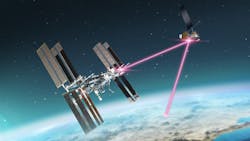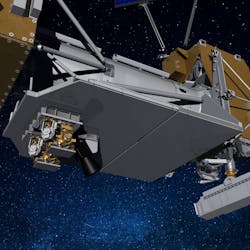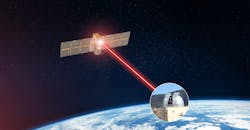More data bandwidth. Faster speeds. Decreased size, weight, power, and costs. Flexibility. Getting away from the overcrowded radio frequency (RF) spectrum. These are merely a handful of benefits infrared lasers and optical links can bring to transmitting information to and from spacecraft.
On December 7, 2021, NASA’s LCRD project launched into geosynchronous orbit, 22,000 miles above Earth, hosted aboard the U.S. Department of Defense’s Space Test Program Satellite 6. The goal: test the capabilities of laser communications as an alternative to radio waves, which have been used for space communications since the beginning of space exploration.
“After many years of people predicting optical comms was the way things are going in the future, we’re now in the era of it’s here,” says Dave Israel, Laser Communications Relay Demonstration principal investigator for NASA at Goddard Space Flight Center. “Optical comms is past the phase of being a technology that ‘may’ be possible.”
Laser comms
Why infrared lasers? Infrared beams can pack data into significantly tighter waves than RF systems, which means ground stations can receive more data in one downlink.
Optical comms involves sending a narrow beam from one location pointed directly at a receiver in another location (see Fig. 1), and an optical communications telescope’s pointing must be extremely precise to reach its target—especially if it’s thousands or even millions of miles away.
The LCRD payload is attached to a support assembly flight (LSAF), which serves as the backbone for LCRD’s components (see Fig. 2). It has a star tracker and two optical modules to generate the infrared lasers that transmit data to and from Earth, and modems to encode data into laser signals attached to the backside of the LSAF.LCRD’s two independent optical communications terminals, each have their own optical module or telescope that’s 10-centimeters in diameter. “They’re each connected to their own modem,” explains Israel. “There’s also a bit of controller electronics involved, too: a computer system is connected to the optical module that does the most difficult part, the acquisition and the tracking, because narrow laser beams make it challenging.”
The two optical communications terminals can each do their own bidirectional link to something on the other side. And a switch between the two terminals allows the data to be switched to go from one terminal to another. There’s also a bidirectional RF link that the data can be switched to, if necessary, so it gets sent down to White Sands, NM.
“We’re demonstrating the ability to do relay links, optical links, designed to send data to and from a user in orbit, which then gets relayed down to Earth,” he says. “We use RF as a backup if the clouds or space junk are bad and we can’t get the data down.”
Although the optical relay is expected to help NASA reach higher data rates, “the most significant part of our mission is to get these links to work through the atmosphere, deal with weather effects, and get down to the ground station,” says Israel. “We’re working to demonstrate and understand how to communicate through the atmosphere as best we can when it’s not cloudy, and when it is cloudy, to be able to predict and determine when to switch to a different ground station, and to understand all of these operational concerns.”
Later in its mission, LCRD will serve as a relay between an optical communications terminal on the International Space Station (ISS) and ground stations.
Gaining operational experience
A Lunar Laser Communications Demonstration (LLCD) project flew to the moon in 2013, and it proved a laser comms system could be built to survive launch and operate in space, and do all of the pointing and tracking through the lunar orbit and the atmosphere and weather down to Earth.
“But it was a short-lived experiment, because part of the mission for the LADEE spacecraft orbiting the moon was for it to crash into the moon and make measurements of lunar dust,” says Israel. “We proved the technology, but didn’t get that much operational experience from it. So we have years, decades, of experience communicating to and from space using RF links, and it’s sort of built into how we design and operate systems.”
NASA doesn’t yet have operational experience for optical links, so a key part of the LCRD technology demonstration mission is to gain it before using optical comms for an operational science or exploration application.
So far, they’ve established there’s a certain point at which it’s too cloudy to talk to the ground station or if space junk is in the way. But a key question now is how well NASA can predict when it’s going to become too cloudy and plan in advance to switch to a different ground station, and how many ground stations are needed.
Benefits of optical comms
The first optical comms benefit most people tend to think of is achieving higher data rates— it provides more bandwidth to move data. “One of the real benefits for space missions is that exchange data rate, because for optical comms, involves a smaller wavelength than the RF systems,” says Israel.
Decreasing size, weight, power, and costs are also big benefits. “It turns out, the size of the telescopes involved in space and on the ground are much smaller than the size required for an
RF link,” says Israel. “This reduces size, weight, and power, which is important on the spacecraft side to being able to build and launch it, but also on the ground side. Using a 1-meter telescope as opposed to an 18-meter large steel antenna really reduces the cost on the ground side to build and operate the systems.”
Optical comms also provide the flexibility to switch to RF whenever necessary, which of course comes in handy when weather or space junk aren’t cooperating.
And getting away from RF spectrum overcrowding and interference issues is another huge benefit of optical comms.
More NASA optical comms projects in the works
While NASA isn’t quite ready to share in-depth details about LCDR’s performance, results and a paper should hopefully be ready in Spring of 2023.
“There have been cases where the link has performed a little better than expected through the atmosphere. We’re still refining our models and starting to see things we were hoping to see from computer- and lab-based models,” says Israel. “We’re seeing some performance that’s different than the predictions.”
In 2022, a project called Terabyte Infrared Delivery (TBIRD) launched to showcase the high-data-rate capabilities of laser communications from a CubeSat within low-Earth orbit (see Fig. 3). TBIRD is about the size of a small lunchbox and will demonstrate its downlink at 200 Gigabits/s, which is much faster than possible in RF. It’s also 200x faster than LCRD, and more than 100x faster than the highest fiber-optic internet speeds. These data rates will enable TBIRD to downlink large amounts of data in bursts as it passes over optical ground stations.NASA also has an upcoming launch in 2023 of a payload called ILLUMA-T, short for Integrated LCRD Low-Earth Orbit User Modem and Amplifier Terminal, which will fly aboard the International Space Station. It will gather data and send it to LCRD at 1.2 Gigabits/s. Once operational, LCRD and ILLUMA-T will be the first fully operational end-to-end laser comms system.
In 2024, the Orion Artemis II Optical Communications System (O2O) will take laser comms to the Moon aboard NASA’s Orion spacecraft during the Artemis II mission. It’s expected to transmit high-resolution images and video and will be the first crewed lunar flight to demonstrate laser comms, sending data to Earth at a downlink rate as much as 260 Megabits/s.
But that’s not all—NASA also plans to boldly take optical comms into deep space and is currently working on a future terminal to explore how laser comms will fare against extreme distances and pointing constraints.

Sally Cole Johnson | Editor in Chief
Sally Cole Johnson, Laser Focus World’s editor in chief, is a science and technology journalist who specializes in physics and semiconductors. She wrote for the American Institute of Physics for more than 15 years, complexity for the Santa Fe Institute, and theoretical physics and neuroscience for the Kavli Foundation.


